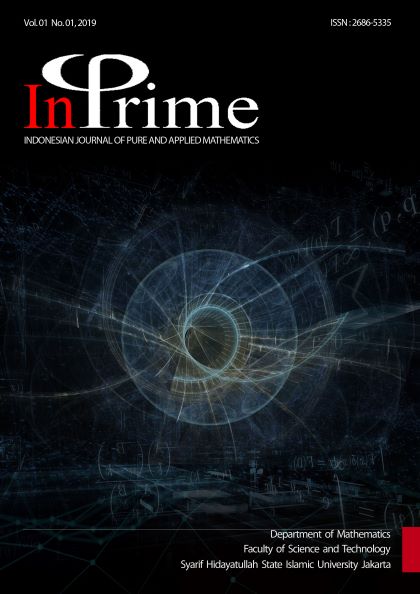Application of Fuzzy K-Nearest Neighbor (FKNN) to Detect the Parkinson’s Disease
DOI:
https://doi.org/10.15408/inprime.v1i1.12827Abstract
AbstractParkinson’s disease is a neurological disorder in which there is a gradual loss of brain cells that make and store dopamine. Researchers estimate that four to six million people worldwide, are living with Parkinson’s. The average age of patients is 60 years old, but some are diagnosed at age 40 or even younger and the worst thing is some patients are late to find out that they have Parkinson's disease. In this paper, we present a diagnosis system based on Fuzzy K-Nearest Neighbor (FKNN) to detect Parkinson’s disease. We use Parkinson’s disease dataset taken from UCI Machine Learning Repository. The first step is normalize the Parkinson’s disease dataset and analyze using Principal Component Analysis (PCA). The result shows that there are four new factors that influence Parkinson’s disease with total variance is 85.719%. In classification step, we use several percentage of training data to classify (detect) the Parkinson's disease i.e. 50%, 60%, 70%, 75%, 80% and 90%. We also use k = 3, 5, 7, and 9. The classification result shows that the highest accuracy obtained for the percentage of training data is 90% and k = 5, where 19 are correctly classified i.e. 14 positive data and 5 negative data, while 1 positive data is classified incorrectly.
Keywords: Parkinson's disease; Fuzzy K-Nearest Neighbor; Principal Component Analysis.
Abstrak
Penyakit Parkinson merupakan kelainan sel saraf pada otak yang menyebabkan hilangnya dopamin pada otak. Para peneliti mengestimasi bahwa, empat sampai enam juta orang di dunia, menderita Parkinson. Penyakit ini rata-rata diderita oleh pasien berusia 60 tahun, namun beberapa orang terdeteksi saat berusia 40 tahun atau lebih muda dan hal terburuk adalah seseorang terlambat untuk mendeteksinya. Di dalam artikel ini, kami menyajikan sistem diagnosa penyakit Parkinson menggunakan metode Fuzzy K-Nearest Neighbor (FKNN). Kami menggunakan Data uji yang diperoleh dari UCI Machine Learning Repository yang telah banyak diterapkan pada masalah klasifikasi. Tahapan pertama yang kami lakukan adalah menormalisasi data kemudian menganalisisnya menggunakan Analisis Komponen Utama (Principal Component Analysis). Hasil Analisis Komponen Utama menunjukkan bahwa terdapat empat factor baru yang mempengaruhi penyakit Parkinson dengan variansi total 87,719%. Pada tahap klasifikasi, kami menggunakan beberapa prosentase data latih untuk mendeteksi penyakit yaitu 50%, 60%, 70%, 75%, 80% and 90%. Selain itu, kami menggunakan beberapa nilai k yaitu 3, 5, 7, and 9. Hasil menunjukkan bahwa klasifikasi dengan akurasi tertinggi diperoleh untuk 90% data latih dengan k = 5, dimana 19 diklasifikasikan secara tepat yaitu 14 data positif dan 5 data negatif, sedangkan satu data positif tidak diklasifikasikan dengan tepat.
Keywords: penyakit Parkinson; Fuzzy K-Nearest Neighbor; Analisis Komponen Utama.
References
Partners in Parkinson, Inc, "Partners In Parkinson's," AbbVie, Chicago, 2014.
J. S. Purba, Penyakit Parkinson, Jakarta: Badan Penerbit FKUI, 2012.
Tech Differences, "Tech Differences," 2 January 2018. [Online]. Available: https://techdifferences.com/. [Accessed 2 11 2019].
D. C. R. Novitasari, Suwanto, M. H. Bisri and A. H. Asyhar, "Classification of EEG Signals using Fast Fourier Transform (FFT) and Adaptive Neuro Fuzzy Inference System (ANFIS)," Jurnal Matematika "MANTIK", vol. 5, no. 1, pp. 35-44, 2019.
D. C. R. Novitasari, W. T. Puspitasari, P. Wulandari, A. Z. Foeady and M. F. Rozi, "Klasifikasi Alzheimer dan Non Alzheimer Menggunakan Fuzzy C-Mean, Gray Level Co-Occurence Matrix dan Support Vector Machine," Jurnal Matematika "MANTIK", vol. 4, no. 2, pp. 83-89, 2018.
N. Afifah, D. C. R. Novitasari and A. Lubab, "Pengklasteran Lahan Sawah Di Indonesia Sebagai Evaluasi Ketersediaan Produksi Pangan Menggunakan Fuzzy C-Means," Jurnal Matematika "MANTIK", vol. 2, no. 1, pp. 40-45, 2016.
D. C. R. Novitasari, "Klasifikasi Sinyal EEG Menggunakan Metode Fuzzy C-Means Clustering (FCM) Dan Adaptive Neighborhood Modified Backpropagation (ANMBP)," Jurnal Matematika "MANTIK", vol. 1, no. 1, pp. 31-36, 2015.
D. C. R. Novitasari, "Klasifikasi Sinyal Eeg Menggunakan Metode Fuzzy C-Means Clustering (FCM) dan Adaptive Neuro Fuzzy Inference System (ANFIS)," ITS, 2013.
F. Febrianti, M. Hafiyusholeh and A. H. Asyhar, "Perbandingan Pengklusteran Data Iris Menggunakan Metode K-Means dan Fuzzy C-Means," Jurnal Matematika "MANTIK", vol. 2, no. 1, pp. 7-13, 2016.
A. A. I. Wiratmaka, I. F. R. Asmara and R. Andrie, "Klasifikasi Kualitas Tanaman Cabai Menggunakan Metode Fuzzy K-nearst Neighbor (Fknn)," Jurnal Informatika Polinema, vol. 3, no. 3, p. 1, Maret 2017.
S. A. Dudani, "The Distance-Weighted k-Nearest-Neighbor Rule," IEEE TRANSACTIONS ON SYSTEMS, MAN, AND CYBERNETICS, pp. 325-327, 1976.
I. Jolliffe, Principal Component Analysis, 2nd ed., New York: Springer-Verlag, 2002.
R. Susetyoko and E. Purwantini, Teknik Reduksi Dimensi Menggunakan Komponen Utama Data Partisi Pada Pengklasifikasian Data Berdimensi Tinggi dengan Ukuran Sample Kecil, Surabaya: EEPIS Repository, 2011.
E. Prasetyo, Data Mining, Mengolah Data menjadi Informasi menggunakan Matlab 1st Ed., Yogyakarta: ANDI , 2014.
A. S. P. A. Dewi and I. Candra, "Implementasi Algoritma Fuzzy K-Nearest Neighbor untuk Penentuan Lulus Tepat Waktu (Studi Kasus : Fakultas Ilmu Komputer Universitas Brawijaya)," Jurnal Pengembangan Teknologi Informasi dan Ilmu Komputer, vol. 3, no. 3, pp. 1726-1732, April 2018.
K. Toduka and Y. Endo, "Fuzzy K-nearest Neighbor and Its Application to Recognize of te Driving Environtment," IEEE International Conference on Fuzzy Systems, 2006.

